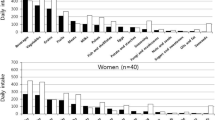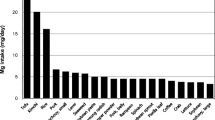Abstract
Manganese (Mn) is an essential element for the body’s composition and is required for various functions, including nutrient metabolism, immune system function, and antioxidant ability. However, there are insufficient data on the nutritional status of Mn. In this study, we aimed to analyze the relationship between Mn intake and urinary excretion in Korean adults. A twice dietary intake survey using a 24-h recall method was conducted on 640 adults (320 men and 320 women), aged 20 to 69 years. Eighty 24-h urine samples were also twice collected and urinary Mn excretions were analyzed. Results indicated that total Mn intake per day was 4.1 mg for men and 3.9 mg for women (p < 0.05). Mn intake per 1000 kcal of energy consumption was significantly higher in women than in men (2.0 mg/1,000 kcal vs. 2.2 mg/1000 kcal, p < 0.01). Additionally, Mn intake as a percentage of Adequate Intake was 103.0% for men and 110.3% for women (p < 0.05). Mn was mostly consumed from cereals (1.78 mg/day for men and 1.53 mg/day for women), followed by vegetables, seasonings, fruits, and pulses. The main food sources of Mn were rice (27.8% for men, 22.0% for women), kimchi (3.5% for men, 1.4% for women), and tofu (2.8% for men, 2.3% for women); the percentage of Mn consumed from 20 types of foods was 55.6% (women) to 60.4% (men). Urinary Mn excretion was negatively correlated with Mn intake from cereals and positively with mushrooms only for women after adjusting for confounding factors (p < 0.05). In conclusion, dietary Mn intake by Korean adults was adequate to meet the Dietary Reference Intake, but the relationship between Mn intake and urinary excretion was not clear.


Similar content being viewed by others
References
Watts DL (1990) The nutritional relationships of manganese. J Orthomol Med 5:219–222
Davis CD, Zech L, Greger JL (1993) Manganese metabolism in rats: an improved methodology for assessing gut endogenous losses. Proc Soc Exp Biol Med 202:103–108
Keen CL, Zidenberg-Cherr S (1994) Manganese toxicity in humans and experimental animals. In: Klimis-Tavantzis DJ (ed) Manganese in health and disease. CRC Press, Boca Raton, pp 193–205
Karki P, Lee E, Aschner M (2013) Manganese neurotoxicity: a focus on glutamate transporters. Ann Occup Environ Med 25:4–5. https://doi.org/10.1186/2052-4374-25-4
Meltzer HM, Brantsaeter AL, Borch-Iohnsen B, Ellingsen DG, Alexander J, Thomassen Y, Stigum H, Ydersbond TA (2010) Low iron stores are related to higher blood concentrations of manganese, cobalt and cadmium in non-smoking, Norwegian women in the HUNT 2 study. Environ Res 110:497–504. https://doi.org/10.1016/j.envres.2010.03.006
Kim Y, Lee BK (2011) Iron deficiency increases blood manganese level in the Korean general population according to KNHANES 2008. Neurotoxicology 32:247–254. https://doi.org/10.1016/j.neuro.2010.12.006
Dorman DC, Struve MF, James RA, McManus BE, Marshall MW, Wong BA (2001) Influence of dietary manganese on the pharmacokinetics of inhaled manganese sulfate in male CD rats. Toxicol Sci 60:242–251. https://doi.org/10.1093/toxsci/60.2.242
McLeod BE, Robinson MF (1972) Metabolic balance of manganese in young women. Br J Nutr 27:221–227
Patterson KY, Holbrook JT, Bodner JE, Kelsay JL, Smith JC Jr, Veillon C (1984) Zinc, copper, and manganese intake and balance for adults consuming self-selected diets. Am J Clin Nutr 40:1397–1403. https://doi.org/10.1093/ajcn/40.6.1397
Gibson RS (1994) Content and bioavailability of trace elements in vegetarian diets. Am J Clin Nutr 59:1223S–1232S. https://doi.org/10.1093/ajcn/59.5.1223S
Greger JL, Davis CD, Suttie JW, Lyle BJ (1990) Intake, serum concentrations, and urinary excretion of manganese by adult males. Am J Clin Nutr 51:457–461. https://doi.org/10.1093/ajcn/51.3.457
Kies C (1994) Bioavailability of manganese. In: Klimis-Tavantzis DL (ed) Manganese in health and disease. CRC Press, Boca Raton, pp 39–58
Freeland-Graves JH, Turnlund JR (1996) Deliberations and evaluations of the approaches, endpoints and paradigms for manganese and molybdenum dietary recommendations. J Nutr 126:2435S–2440S. https://doi.org/10.1093/jn/126.suppl_9.2435S
Friedman BJ, Freeland-Graves JH, Bales CW, Behmardi F, Shorey-Kutschke RL, Willis RA, Crosby JB, Trickett PC, Houston SD (1987) Manganese balance and clinical observations in young men fed a manganese-deficient diet. J Nutr 117:133–143. https://doi.org/10.1093/jn/117.1.133
Greger JL (1998) Dietary standards for manganese: overlap between nutritional and toxicological studies. J Nutr 128:368S–371S. https://doi.org/10.1093/jn/128.2.368S
Choi MK, Kim EY (2007) Analysis of manganese content in frequently consumed foods by Koreans. Korean J Nutr 40:769–778
Rural Development Administration, National Institute Agricultural Sciences (ed) (2016) Korean food composition table. 9th rev. ed. Rural Development Administration, National Institute Agricultural Sciences, Wanju
Sorenson AW, Wyse BW, Wittwer AJ, Hansen RG (1976) An Index of Nutritional Quality for a balanced diet. New help for an old problem. J Am Diet Assoc 68:236–242
Knuiman JT, Hautvast JG, van der Heijden L, Geboers J, Joossens JV, Tornqvist H, Isaksson B, Pietinen P, Tuomilehto J, Flynn A et al (1986) A multi-centre study on within-person variability in the urinary excretion of sodium, potassium, calcium, magnesium and creatinine in 8 European centres. Hum Nutr Clin Nutr 40:343–348
Kong JS, Lee YK, Kim MK, Choi MK, Heo YR, Hyun T, Kim SM, Lyu ES, Oh SY, Park HR, Rhee MY, Ro HK, Song MK (2018) Estimation model for habitual 24-hour urinary-sodium excretion using simple questionnaires from normotensive Koreans. PLoS One 13:e0192588. https://doi.org/10.1371/journal.pone.0192588
Banta RG, Markesbery WR (1977) Elevated manganese levels associated with dementia and extrapyramidal signs. Neurology 27:213–216
Hurley LS, Keen CL (1989) Manganese. In: Mertz W (ed) Trace Elements in Human and Animal Nutrition, 5th edn. Academic Press, San Diego, pp 185–221
Claus Henn B, Ettinger AS, Schwartz J, Téllez-Rojo MM, Lamadrid-Figueroa H, Hernández-Avila M, Schnaas L, Amarasiriwardena C, Bellinger DC, Hu H, Wright RO (2010) Early postnatal blood manganese levels and children's neurodevelopment. Epidemiology 21:433–439
Rodriguez-Barranco M, Lacasana M, Aguilar-Garduno C, Alguacil J, Gil F, Gonzalez-Alzaga B, Rojas-Garcia A (2013) Association of arsenic, cadmium and manganese exposure with neurodevelopment and behavioural disorders in children: a systematic review and meta-analysis. Sci Total Environ 454-455:562–577. https://doi.org/10.1016/j.scitotenv.2013.03.047
Davidsson L, Cederblad A, Lönnerdal B, Sandström B (1991) The effect of individual dietary components on manganese absorption in humans. Am J Clin Nutr 54:1065–1070. https://doi.org/10.1093/ajcn/54.6.1065
Institute of Medicine (2001) Dietary reference intakes for vitamin a, vitamin k, arsenic, boron, chromium, copper, iodine, iron, manganese, molybdenum, nickel, silicon, vanadium, and zinc. National Academies Press, Washington, D.C., pp 394–419
Thomas JW (1970) Metabolism of iron and manganese. J Dairy Sci 53:1107–1123. https://doi.org/10.3168/jds.S0022-0302(70)86354-8
Robberecht HJ, Hendrix P, Van Cauwenbergh R, Deelstra HA (1994) Daily dietary manganese intake in Belgium, using duplicate portion sampling. Z Lebensm Unters Forsch 199:446–448
Tripathi RM, Mahapatra S, Raghunath R, Sastry VN, Krishnamoorthy TM (2000) Daily intake of manganese by the adult population of Mumbai. Sci Total Environ 250:43–50. https://doi.org/10.1016/S0048-9697(00)00360-0
Leblanc JC, Guérin T, Noël L, Calamassi-Tran G, Volatier JL, Verger P (2005) Dietary exposure estimates of 18 elements from the 1st French Total Diet Study. Food Addit Contam 22:624–641. https://doi.org/10.1080/02652030500135367
Rose M, Baxter M, Brereton N, Baskaran C (2010) Dietary exposure to metals and other elements in the 2006 UK Total Diet Study and some trends over the last 30 years. Food Addit Contam Part A Chem Anal Control Expo Risk Assess 27:1380–1404. https://doi.org/10.1080/19440049.2010.496794
Yamada M, Asakura K, Sasaki S, Hirota N, Notsu A, Todoriki H, Miura A, Fukui M, Date C (2014) Estimation of intakes of copper, zinc, and manganese in Japanese adults using 16-day semi-weighed diet records. Asia Pac J Clin Nutr 23:465–472. https://doi.org/10.6133/apjcn.2014.23.3.05
Choi MK, Bae YJ (2013) Relationship between dietary magnesium, manganese, and copper and metabolic syndrome risk in Korean adults: the Korea National Health and Nutrition Examination Survey (2007-2008). Biol Trace Elem Res 156:55–66. https://doi.org/10.1007/s12011-013-9852-z
Buchet JP, Lauwerys R, Vandevoorde A, Pycke JM (1983) Oral daily intake of cadmium, lead, manganese, copper, chromium, mercury, calcium, zinc and arsenic in Belgium: a duplicate meal study. Food Chem Toxicol 21:19–24. https://doi.org/10.1016/0278-6915(83)90263-6
Rubio C, Gutiérrez AJ, Revert C, Reguera JI, Burgos A, Hardisson A (2009) Daily dietary intake of iron, copper, zinc and manganese in a Spanish population. Int J Food Sci Nutr 60:590–600. http://doi.org/. https://doi.org/10.3109/09637480802039822
Filippini T, Cilloni S, Malavolti M, Violi F, Malagoli C, Tesauro M, Bottecchi I, Ferrari A, Vescovi L, Vinceti M (2018) Dietary intake of cadmium, chromium, copper, manganese, selenium and zinc in a Northern Italy community. J Trace Elem Med Biol 50:508–517. https://doi.org/10.1016/j.jtemb.2018.03.001
Tureck C, Locateli G, Correa VG, Koehnlein EA (2017) Evaluation of the Brazilian population’s intake of antioxidant nutrients and their relation with the nutritional status. Rev Bras Epidemiol 20:30–42. https://doi.org/10.1590/1980-5497201700010003
Zhou B, Su X, Su D, Zeng F, Wang MH, Huang L, Huang E, Zhu Y, Zhao D, He D, Zhu X, Yeoh E, Zhang R, Ding G (2016) Dietary intake of manganese and the risk of the metabolic syndrome in a Chinese population. Br J Nutr 116:853–863. https://doi.org/10.1017/S0007114516002580
Lidon FC, Barreiro MG, Ramalho JC (2004) Manganese accumulation in rice: implications for photosynthetic functioning. J Plant Physiol 161:1235–1244. https://doi.org/10.1016/j.jplph.2004.02.003
Sales CH, Fontanelli MM, Vieira DA, Marchioni DM, Fisberg RM (2017) Inadequate dietary intake of minerals: prevalence and association with socio-demographic and lifestyle factors. Br J Nutr 117:267–277. https://doi.org/10.1017/S0007114516004633
Lucchini A, Selis L, Folli D, Apostoli P, Mutti A, Vanoni O, Iregren A, Alessio L (1995) Neurobehavioral effects of manganese in workers from a ferroalloy plant after temporary cessation of exposure. Scand J Work Environ Health 21:143–149. https://doi.org/10.5271/sjweh.1369
Wu C, Woo JG, Zhang N (2017) Association between urinary manganese and blood pressure: Results from National Health and Nutrition Examination Survey (NHANES), 2011-2014. PLoS One 12:e0188145. https://doi.org/10.1371/journal.pone.0188145
Shiue I (2014) Higher urinary heavy metal, phthalate, and arsenic but not parabens concentrations in people with high blood pressure, U.S. NHANES, 2011-2012. Int J Environ Res Public Health 11:5989–5999. https://doi.org/10.3390/ijerph110605989
Acknowledgments
This work was supported by the research grant of the Kongju Naitonal University in 2018.
Author information
Authors and Affiliations
Corresponding author
Ethics declarations
The study followed the guidelines of the Declaration of Helsinki and all participants provided their written informed consent.
Conflicts of Interest
The authors of this study declare that there is no conflict of interest.
Additional information
Publisher’s Note
Springer Nature remains neutral with regard to jurisdictional claims in published maps and institutional affiliations.
Rights and permissions
About this article
Cite this article
Choi, MK., Bae, Y.J. Dietary Intake and Urinary Excretion of Manganese in Korean Healthy Adults. Biol Trace Elem Res 196, 384–392 (2020). https://doi.org/10.1007/s12011-019-01932-y
Received:
Accepted:
Published:
Issue Date:
DOI: https://doi.org/10.1007/s12011-019-01932-y




